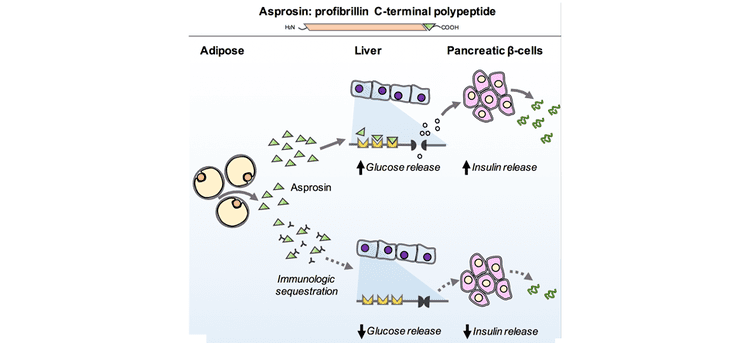Symbol FBN1 HUGO 3603 RefSeq NP_000129 | Entrez 2200 OMIM 134797 UniProt P35555 | |
 | ||
Asprosin is a protein hormone produced by mammals in their fatty (white adipose) tissues that stimulates the liver to release glucose into the blood stream. In these tissues, asprosin is encoded by the gene FBN1, which also encodes the protein fibrillin. In the liver, asprosin activates rapid glucose release via a cyclic adenosine monophosphate (cAMP) dependent pathway. People with Marfan lipodystrophy syndrome (MFLS) are deficient in asprosin, while people with insulin resistance and obesity have it in abundance.
Contents
Background
Asprosin is a protein hormone that has been found to be produced by white adipose tissue in mammals; it is transported to the liver, where it stimulates the release of glucose into the blood stream, via a cAMP-dependent pathway.
Glucose released by the liver into the blood stream is required for the normal function of the brain and other organs, as well as for survival during fasting and other aspects of mammalian function. People with Marfan lipodystrophy syndrome are deficient in asprosin, while people presenting the condition of insulin resistance and obesity produce it in abundance.
Discovery and function
Asprosin was first identified by Dr. Atul Chopra and coworkers at Baylor College of Medicine as a C-terminal cleavage product of the FBN1 gene product profibrillin. They found mutations in the FBN1 gene in two patients with congenital partial lipodystrophy and a progeroid appearance. Truncations of the FBN1 protein in these patients were seen to have two consequences for protein production: a mutant/truncated fibrillin protein and very low plasma asprosin levels (from a postulated dominant negative effect).
Therapeutic potential
In a test of pharmacologic asprosin depletion in animals, preliminary results raised the possibility of its use, therapeutically, in treating type 2 diabetes. Specifically, Chopra and coworkers observed that when antibodies targeting asprosin were injected into diabetic mice, blood glucose and insulin levels improved.
